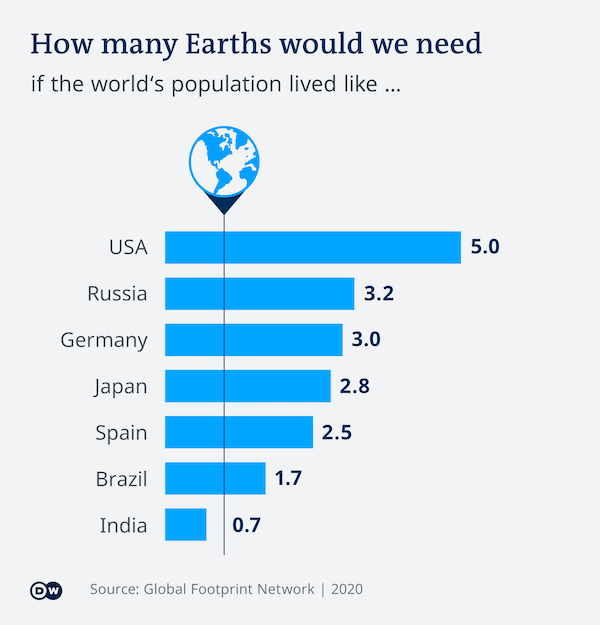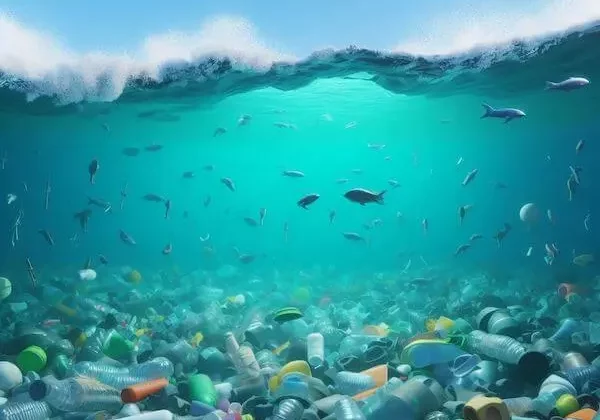
Continue exploring conscious consumerism by reading our next article. We discuss how to identify sustainable brands and share our list of 10 brands that we love!
For the past year, Kevin and I have been reflecting on consumerism and what shopping has become. Through this reflection, we’ve been expanding our awareness about what it means to be a conscious consumer.
You know exactly what I’m talking about, the allure of massive discounts, irresistible deals, and the excitement of shopping sprees. But lately, we’ve been rethinking the way we shop while considering the environmental impact of our choices as consumers because of, well…climate change.
Beneath those enticing discounts and irresistible deals lies a deeper, less celebrated story – the significant environmental impact of overconsumption. So while the environment is suffering and the average American is spending more and more, companies are generating billions in profit and increasing annual revenue increasing, especially during the holiday seasons.
So this time around, we want to give you a different perspective. We want to share how you can become a more conscious consumer, without causing further damage to the environment or your wallet.
Table of Contents
The Environmental Impact of Ignoring Conscious Consumerism
How to Be a More Conscious Consumer
The Environmental Impact of Ignoring Conscious Consumerism

The Carbon Footprint of Ignoring Conscious Consumerism
Here’s the truth – overconsumption is a significant contributor to increased carbon emissions. Think about it. A surge in shopping activities means increased transportation, more energy consumption, and faster manufacturing, all of which take a toll on the environment. Oh yeah, not to mention, when we rush from store to store, often traveling long distances, it adds to the carbon footprint. On top of that, all the energy that’s required in stores, shopping malls, and online retailers during this period contributes to increased greenhouse gas emissions!
Look, I know what you’re thinking.
It’s so cheap…
50% off!
The discounts…
But ultimately, overconsumption isn’t about us. Those deals and discounts aren’t created with shoppers in mind—they’re designed to pump up the companies’ balance sheets and the C-Suite executives’ wallets. Consumerist events, like seasonal or holiday sales, are some of the most effective ways big brands are exploiting the working class for profit.
Overconsumption pushes consumerism to its extremes by telling us we need more unnecessary, unwanted, cheap goods made from poor-quality, unsustainable materials. This means there’s an increase in pollution during mining, the depletion of natural resources, and more pollution from transportation. Yes, getting things to us causes pollution!
I know we all have those cheap shirts, pants, shoes, kitchenware, or other household items that we got at a major discount but didn’t last that long! It’s because when things are cheap, the quality sucks, and it hurts the environment in the making.
Even more concerning is the unstoppable rise of e-commerce. All of this online shopping means more transactions, which leads to more emissions created, more waste generated, and more trucks dispatched to meet our demands. You can get something shipped from TikTok, Temu, and AliExpress for less than a few dollars; just think about how much packaging is used for these tiny orders! Our eagerness to get something delivered quickly (thanks, Amazon Prime) all adds to our online shopping carbon footprint.
Reports show that 1 in 10 shoppers (11.72%) factor carbon-friendly delivery into their decision when purchasing online. Of those surveyed, 35% look for the least “green” delivery option of next-day delivery when making a purchase online because it’s cheaper. 16% of 16 to 24 year olds say carbon-conscious delivery factors into their online shopping decisions, which is twice as many as the 55+ age group, with just 8% saying this.

As someone who loves to shop, I never thought about this before. But now it’s too hard to ignore. We have to start thinking about the way we consume in this world and the effects of our spending. And the first step is to have the information so that we fully understand the environmental consequences of our actions, thereby paving the way to becoming more conscious consumers.

Fast Fashion and E-Waste
There’s no doubt that neglecting conscious consumerism exacerbates the problem with the fast fashion industry. If you’re like me, you’ve probably got a few items from large fast fashion brands like H&M, Zara, and SHEIN. These brands prioritize speed and affordability, which means their quality is poor with a limited lifespan.
I get it. We all love cheap and fashionable clothing, especially for those of us who are young, dumb, and broke. So we often overlook the problems that fast fashion brings.
The truth is that we keep buying new clothes because our clothes don’t last. And our clothes don’t last because we buy cheap materials, which are more affordable. Then all the old clothes end up in a dump. Every second, the equivalent of a garbage truck full of clothes is burned or dumped. Then we go look for new clothes. This cycle is precisely what the fast fashion industry thrives on and contradicts the ideals of conscious consumerism.
According to Earth.org, the average person dumps about 81.5 lbs of clothes each year, making throwaway culture progressively worse over time. Other reports show that fashion production makes up 10% of our carbon emissions, dries up water sources, and pollutes rivers and streams.
Just as terrible – the cheap gadgets, appliances, and electronic devices we accumulate through overconsumption.
The consequence? A massive generation of electronic waste (e-waste), mostly caused by the surge of purchases of tech products. These items have a significant environmental footprint, from their production processes to their disposal. This growing problem of e-waste is not only detrimental to the environment but also to our own health.
When you really think about these numbers, it is terrifying.

Single-Use Plastics
Now, for the aftermath of ignoring conscious consumerism – single-use plastics.
Shopping bags, gadgets wrapped in layers of plastic, packaging materials, and more. These plastic wrappings, which are discarded once the items are unwrapped, have far-reaching consequences that contribute to environmental degradation and especially ocean pollution.
Remember those videos you see of marine life tangled in plastic waste, or fish washed up on the shore with plastic in their stomachs? That’s where all the single-use plastic goes.
A common misconception that people have is that there’s nothing wrong with using single-use plastics, like buying water in plastic bottles or plastic utensils, because they’ll recycle it afterward. For all those Asian American families out there, you probably have a basket with tons of plastic bags your parents kept from the grocery store and reused for your own trash bins. But then when we take the trash out, where do the plastic bags go? Not all plastic is recyclable.
It’s not just about where it goes after you use it, it’s also about the production process. Plastic manufacturing greatly contributes to greenhouse gas emissions and is responsible for at least 232 million CO2e gas emissions per year. That’s equivalent to 116 coal-fired power plants or around 50 million cars, according to the EPA.
I know this is a lot to take in, but don’t worry. There are ways we can minimize our use of plastic, one of the greatest contributions we can make as conscious consumers. We won’t be able to solve this problem anytime soon, but we can do our part in helping the environment.
How to Be a More Conscious Consumer
Finding and Prioritizing Sustainable Brands
By this point, you might be wondering, “Well, what can I do about this as a consumer? I still love to shop!”
Look, you don’t have to stop shopping. A part of being a more conscious consumer means being more mindful of the things you’re buying while considering your own spending habits.
One of the most effective ways to reduce the environmental impact of our shopping habits is to support sustainable and eco-friendly brands; brands that prioritize ethical practices, eco-friendly materials, and transparent reporting on their sustainability efforts. This last part is crucial.
Nowadays, many brands engage in what’s called “greenwashing”, which is a deceptive marketing practice that portrays the brand as more environmentally friendly than it truly is. Some brands may label their products as “green,” “eco-friendly,” or “sustainable” without providing clear evidence to support these claims. They might also advertise certain products as eco-friendly, but it doesn’t mean that the company itself practices sustainability.
If we want to do our part, we must seek out well-established certifications and third-party endorsements to verify a brand’s eco-credentials.
So, where should you start?
Sustainable shopping apps and websites provide information on eco-friendly brands and products to help us make more informed choices.
Here are some sustainable apps and websites for ethical shopping:
These resources offer valuable insights into a brand’s environmental impact, ethical practices, and overall commitment to sustainability. They often include information about the materials used, certifications held, and the brand’s adherence to ethical labor practices.
Now, what are some popular, sustainable brands today?
Over the years, people have realized how detrimental shopping and consumerism are to the environment. Because of this, there has been a significant increase in conscious consumers, like us, wanting to change their spending habits.
Here are just some of the great, sustainable brands that we love:
Participate in “Green Friday”
We all know about the frenzy of Black Friday and the negative impact it has created on our Earth. But have you heard of Green Friday?
“Green Friday” promotes conscious consumerism, such as purchasing from small local stores or buying second-hand items. This movement is gaining traction as an alternative to Black Friday and has been embraced by people around the world.
The main purpose of Green Friday is to do exactly what we’ve outlined in this article.
- Be mindful of your shopping habits
- Reconsider your purchasing decisions
- Support small or local businesses and brands
- Support good causes and charity; make donations
- Promote brands with great sustainable practices
Instead of getting swept up in the crazy consumerism that is Black Friday, participating in Green Friday is an opportunity for you to say “Hey, I want to make a difference, and I want my shopping habits to reflect that!”
Green Friday emphasizes the importance of quality over quantity, encouraging more conscious consumers to invest in products that are durable, ethically produced, and have a minimal environmental footprint. It’s all about choosing products that are eco-friendly, responsibly made, and built to last. Imagine a world where every purchase has a positive impact!
Quality Over Quantity
I know it’s hard to say no to an item that’s extremely cheap and discounted. But think about how long that product is actually going to last, whether it’s an article of clothing or a household item. Chances are, you’re going to have to get another one.
Prioritizing quality over quantity is a useful strategy to reduce your environmental footprint. Yes, it’ll cost a bit more but investing in durable, long-lasting products decreases the need for frequent replacements. This means that you spend a little more money on products that are built to last so that you can buy them less frequently.
Quality over quantity is a fundamental principle of sustainable shopping. High-quality products tend to be more durable, so you know for sure that they’ll last longer and require fewer replacements. When you invest in quality items, you not only reduce your environmental impact but also often save money in the long run. This approach promotes conscious consumerism; this is what it means to be mindful when shopping for things you want or need.
Secondhand and Thrift Shopping
I used to love thrift shopping. In high school, I would frequent my local thrift shops and other ones like Salvation Army and Goodwill and could always count on finding something useful.
Opting for secondhand shopping and thrift stores is a sustainable choice. Not only can you discover unique items, but you also do your part as a conscious consumer by giving pre-loved products a second chance.
Thrift stores and secondhand shops offer a treasure trove of unique finds, from clothing and accessories to furniture and electronics. I once bought an old keyboard from a thrift store and kept it for almost 10 years!
Shopping secondhand reduces the demand for new products, which, in turn, reduces the need for manufacturing, packaging, and transportation. By extending the life of these items, you play a role in reducing waste and conserving resources.

Buying Experiences vs Buying Things
I’ve spent most of my life shopping for things. I am now at the age where I’d rather invest in experiences and making memories than buy something I might use or wear a few times.
Experiences are extremely valuable, especially if they’re shared with loved ones. Experiences like concert tickets, spa days, or adventure outings are not only memorable but also more eco-friendly. Consider shifting your focus from material goods to experiences, which create lasting memories and have a lower environmental impact.
One of my favorite gifts to give is Getaway House rentals; adorable tiny cabins in the woods for those who need a quick getaway to relax and unwind. It’s a great way for people to connect with nature and each other while making memories and practicing conscious consumerism.
Buying experiences is not only good for the environment, it’s good for our souls. Experiences build meaningful connections and relationships, which increase our happiness and overall well-being.
And honestly, it’s just more fun!
Final Thoughts
Shopping doesn’t have to be synonymous with excessive consumerism and environmental harm. You can still shop for deals and discounts without causing more damage to our Earth. By adopting a mindful perspective and prioritizing sustainability, you can make a positive impact on the environment.
Remember, every choice you make matters. Choose wisely and make every shopping occasion a time for sustainable, mindful shopping. By doing all of that, you are well on your way to becoming a more conscious consumer!

